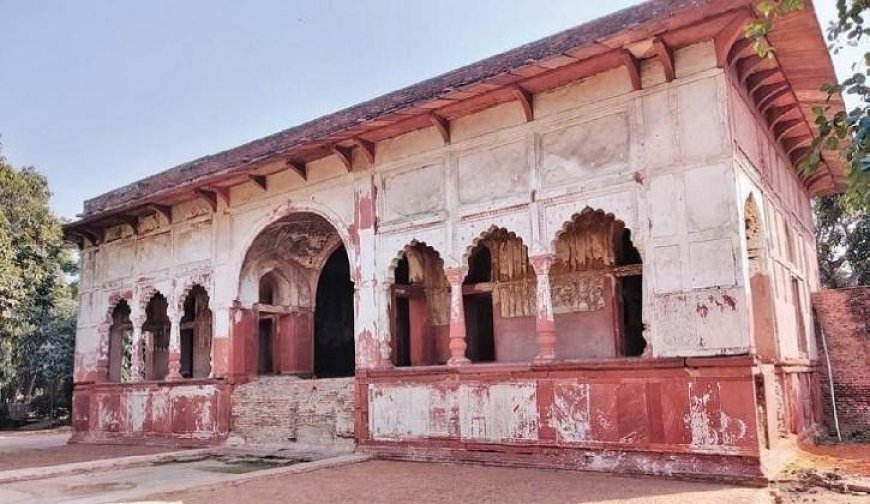Sheesh Mahal Reopens After 370 Years: Delhi’s Mughal-Era Jewel Restored to Glory
Delhi’s historic Sheesh Mahal in Shalimar Bagh has reopened after 370 years following a meticulous restoration, now housing a museum and café. The revival marks a milestone in India’s heritage conservation efforts.

In a major moment for India's architectural and cultural heritage, the Sheesh Mahal, a 17th-century Mughal-era palace located in Delhi’s Shalimar Bagh, has officially reopened to the public. Closed and neglected for centuries, this historic monument has undergone extensive restoration under the Delhi government's heritage conservation initiative and is now set to become a center for cultural exploration and leisure.
A Forgotten Legacy Brought Back to Life
Built during the reign of Mughal Emperor Shah Jahan around 1653 AD, the Sheesh Mahal (translated as “Palace of Mirrors”) was once a symbol of opulence and royal grandeur. Located in the heart of Shalimar Bagh, it was part of a larger Mughal garden complex meant to serve as a retreat for royalty.
Over time, however, the palace fell into disrepair. Damaged by time, weather, and apathy, the structure remained closed and largely inaccessible to the public. That has now changed.
The Restoration: A Multi-Year, Multi-Agency Effort
The revival of Sheesh Mahal was not a simple cosmetic upgrade. The Delhi Department of Archaeology, in collaboration with INTACH (Indian National Trust for Art and Cultural Heritage), undertook an extensive scientific restoration process that included:
-
Structural reinforcement of the crumbling façade
-
Cleaning and preservation of delicate mirror and fresco work
-
Recreation of missing architectural elements in accordance with historical records
-
Installation of modern lighting and ventilation systems to balance aesthetics with preservation
Special care was taken to preserve the Mughal-style stucco and mirror work, which gives the palace its name. Experts say the delicate designs, once dulled by soot and dust, have now been meticulously restored to near-original brilliance.
“This restoration is more than a facelift. It’s a resurrection of history,” said Dr. Aarti Kaul, a heritage conservationist involved in the project. “We’ve blended tradition with technology to bring back a lost chapter of Delhi’s story.”
What’s New: Museum, Cultural Spaces, and Cafés
The newly inaugurated Sheesh Mahal is more than just a preserved building. It has been transformed into a vibrant public space, offering:
1. Heritage Museum
The palace now houses a museum featuring artifacts, archival maps, and digital exhibits tracing the history of the Mughal period in Delhi. Special sections are dedicated to Shah Jahan’s architectural vision and the transformation of Delhi through various dynasties.
2. Café and Leisure Spaces
Modern cafés with outdoor seating have been introduced in the palace courtyard, allowing visitors to soak in history with a cup of coffee in hand. The dining experience has been designed to maintain harmony with the historical setting.
3. Cultural Performances and Guided Tours
Sheesh Mahal will host periodic classical music and dance performances, poetry readings, and historical reenactments. Audio-guided tours and scheduled heritage walks will help deepen visitor engagement.
Why It Matters: Cultural Preservation Meets Public Engagement
The reopening of Sheesh Mahal is significant on multiple fronts:
-
Heritage Conservation: The palace’s revival is a success story in heritage conservation, setting a precedent for the restoration of other neglected sites across India.
-
Tourism Boost: With its rich history and scenic beauty, Sheesh Mahal is expected to become a major tourism draw, both for domestic and international visitors.
-
Community Involvement: Local artisans were engaged in the restoration process, providing livelihood opportunities and cultural continuity.
-
Educational Value: Schools and universities are expected to use the palace as a learning resource on Mughal history and architecture.
Statements from Government and Heritage Bodies
Delhi Chief Minister Arvind Kejriwal, who inaugurated the restored monument, said:
“The revival of Sheesh Mahal is a proud moment for all Delhiites. We are not only protecting our history but turning it into a space for public dialogue, education, and art.”
INTACH Chairperson, Meenakshi Gopinath, added:
“Restoration isn’t just about brick and mortar—it’s about memory, identity, and pride. Sheesh Mahal now stands as a living museum, open to all.”
Accessibility and Entry Details
-
Location: Shalimar Bagh, Delhi
-
Timings: 10 AM – 6 PM (Closed on Mondays)
-
Entry Fee: ₹50 for Indian nationals; ₹200 for foreign tourists
-
Nearest Metro Station: Shalimar Bagh (Pink Line)
Visitors are encouraged to book guided tours online to avoid long queues, especially on weekends.
A New Chapter for Delhi's Heritage Circuit
Sheesh Mahal’s reopening complements other historical revival projects in Delhi, such as the restoration of Qudsia Bagh, Dara Shikoh Library, and Sunder Nursery. Together, these initiatives aim to position Delhi not just as a political capital but also as a cultural capital, rich in layered histories and accessible heritage.
Urban planners also see this revival as part of Delhi’s larger green initiative, integrating heritage gardens with eco-friendly public spaces. The rejuvenated Shalimar Bagh complex is expected to serve as a model for blending history, ecology, and urban design.
Conclusion: From Abandonment to Awe
After centuries of silence, the Sheesh Mahal speaks again—of artistry, imperial grandeur, and cultural pride. This project is not just a triumph for heritage conservation but a powerful reminder of what can be achieved when public institutions, local communities, and experts work together.
In an era where modernity often overshadows history, the revival of Sheesh Mahal is a clarion call: preserving the past can enrich our present and inspire our future.



















































